Abstract
Most wildlife habitats and migratory routes are extremely threatened due to increasing demands on forestland and forest resources by burgeoning human population. Corridor landscape in Biligiri Rangaswamy Temple Tiger Reserve (BRT) is one among them, subjected to various anthropogenic pressures. Human habitation, intensive farming, coffee plantations, ill-planned infrastructure developments and rapid spreading of invasive plant species Lantana camara, pose a serious threat to wildlife habitat and their migration. Aim of this work is to create detailed NDVI based land change maps and to use them to identify time-series trends in greening and browning in forest corridors in the study area and to identify the drivers that are influencing the observed changes. Over the four decades in BRT, NDVI increased in the core area of the forest and reduced in the fringe areas. The change analysis between 1973 and 2014 shows significant changes; browning due to anthropogenic activities as well as natural processes and greening due to Lantana spread. This indicates that the change processes are complex, involving multiple driving factors, such as socio-economic changes, high population growth, historical forest management practices and policies. Our study suggests that the use of updated and accurate change detection maps will be useful in taking appropriate site specific action-oriented conservation decisions to restore and manage the degraded critical wildlife corridors in human-dominated landscape.
1. Introduction
Most wildlife and wildlife habitats are extremely threatened due to increasing demands on forestland and forest resources by burgeoning human population [1,2,3,4]. Urbanization, increase in human habitation, expansion of farmland, forest resource extraction in the wildlife habitats, etc., increase biotic pressure on the forest, and have associated impacts on wild animals [5,6]. Therefore, all forms of anthropogenic interactions with the environment are identified as leading causes of climate change, and they in turn impact the environment and climate either positively or negatively [7].
Human-induced large-scale fragmentation and degradation of natural forests in protected areas (PAs) as well as outside PAs either shrinks wildlife habitat or breaks the continuity of genetic exchanges amongst spatially isolated wildlife populations, and thus causes significant biodiversity loss [8,9]. In such conditions, corridors and connectivity provide an array of ecological and environmental benefits in such a way that corridors link passages or avenues where wide ranging animals can move safely, plants can propagate, genetic interchange can occur, populations can move in response to environmental changes and natural disasters, and threatened species can be replenished from other areas [10].
In Biligiri Rangaswamy Temple Tiger Reserve (BRT), a dry tropical forest of south India, the corridors are critically important for wildlife conservation given their vital role in ecological processes but subjected to various kinds of threats. The anthropogenic pressure due to over harvest of non-timber forest products (NTFP), fuel wood collection, cattle grazing and expansion of settlement coupled with intensive agricultural activities, encroachment and establishment of coffee estates inside or near the buffer zones—mostly wildlife habitats—has brought tremendous biotic pressure on the flora and fauna of the region [11,12,13]. Also ill-planned infrastructure projects such as the construction of roads and various types of barriers in the migratory routes and also an invasive plant species Lantana camara indirectly affect wildlife, wildlife habitats and wildlife migration [14,15,16].
In a given area at a given scale, natural as well as anthropogenic mechanisms can cause fragmentation [17]. From conservation point of view the mechanisms causing habitat fragmentation are often of primary concern, especially when these mechanisms are human-induced [18]. According to classic view of forest fragmentation, the poor habitat quality was a result of breaking up of large intact vegetation type into smaller units dominated by single vegetation type and considered to be ecologically negative [19,20]. Since the habitat quality and quantity are considered to be the primary factors that determine the size and health of wildlife populations, Hall et al. (1997) defined habitat quality as “the ability of the environment to provide conditions appropriate for individual and population persistence” [21]. Therefore, good quality wildlife habitat is one that can provide food, water, vegetation cover and space for wildlife species, where wildlife species can hide, rest, move about, and mate [22]. Therefore, there is an urgent need to quantify and analyze the natural as well as human induced impact on wildlife corridors in order to reverse the process at the earliest [23]. Detailed high-resolution land change maps can be very useful to study and subsequently manage this type of diverse, dynamic and ecologically fragile corridor ecosystem and ensure its sustainability [24].
In due consideration of the present situation in BRT, monitoring ecological responses to natural or man-made disturbances through Normalized Difference Vegetation Index (NDVI) based change-detection techniques can play a crucial role [25] to prioritize and manage corridors as well as the adjacent forests. This is because NDVI carries valuable information regarding land-surface properties, and vegetation changes can be most accurately identified by image differencing of NDVI data [26]. The time-series NDVI data have proven to be appropriate not only for detecting long-term land-use/cover changes but also for modeling terrestrial ecosystems from the global to regional scales [27,28]. Also, the time series NDVI trend detection, either positive (“greening”) or negative (“browning”) can be used to identify and quantify recent changes in ecosystem properties from a local to global scale [29,30]. Therefore, in this study we attempts to understand the changes in vegetation in terms of surface greening and browning to assess the impact of disturbances, either man-made or natural, in the forest-corridor landscape through NDVI datasets derived from Landsat time-series imagery. The major objectives of this study are (a) to identify time-series trends in greening and browning in forest corridors in the study area and (b) to identify the drivers that are influencing the changes observed.
2. Study Site: Biligiri Rangaswamy Temple Tiger Reserve
Biligiri Rangaswamy Temple Tiger Reserve (BRT) is a mountainous biodiversity rich forest landscape located towards east from the Western Ghats (11°43'–12°09'N and 77°01'–77°15'E). Further to the south, BRT is linked with Satyamanglam Tiger Reserve and Nilgiri Biosphere Reserve (11°36'–12°00'N and 76°00'–77°15'E). On the east and north-eastern side, through Edeyarahalli Reserve Forest, BRT is linked with Malai Madheswara Reserve Forest (MM Hills), Cauvery Wildlife Sanctuary and further to Bannerghatta National Park. The Tiger Reserve is approximately 50 km long north-south and 25 km wide east-west and is spread over an area of 540 km2 (Figure 1). Historically 322.4 km2 of the wildlife sanctuary was created around the temple on 27 June 1974, and extended to 539.52 km2 on 14 January 1987 [31]. In December 2010 it was declared as a Tiger Reserve, which is the second Tiger Reserve in Chamarajanagar District and fifth in the Karnataka state [32].
The altitude of BRT ranges from 600 m to 1800 m and the temperature ranges from 9 °C to 16 °C in winter and 20 °C to 38 °C in summer. The annual rainfall varies from 600 mm at the foothills to 3000 mm on the higher elevations. The span of altitude, temperature and rainfall makes the area highly heterogeneous, and supports diverse flora and fauna distributed in a wide range of habitat types [33]. The greater proportion of BRT and its corridor landscape is covered by deciduous and scrub forests. Other forest types are evergreen forests, high altitude grasslands and shola (montane) forests. The forests harbor more than 1000 species of flowering plants showing a close affinity to the Western Ghats [34,35]. The BRT forest is home to 34 Bengal tigers, 254 species of birds and 30 species of mammals [13,36,37]. Out of the 30 species of mammals, 14 are globally threatened species, especially IUCN red listed mammals such as Asian elephant (Elephas maximus), Bengal tiger (Panthera tigris), Indian leopard (Panthera pardus) and Indian wild dog (Cuon alpinus) [38,39].
In the years succeeding the declaration of the BRT as a Sanctuary in 1974, shifting cultivation and hunting was banned. This led to the establishment of Podus or settlements of 10 to 60 households by the forest department on the periphery of the forest to accommodate native tribal people, the Soligas, who migrated from different parts of the forest [40] and settled into these colonies. At present, approximately 6000 Soliga tribal people live in 64 settlements of BRT. The forest fringe communities comprise both Soligas and other communities, where Soligas can access these forests mainly for fuel wood, fodder and NTFPs collection [41]. Though, legally speaking, other communities are not allowed to harvest NTFPs, but they are known to collect fuel wood and graze their cattle [42].
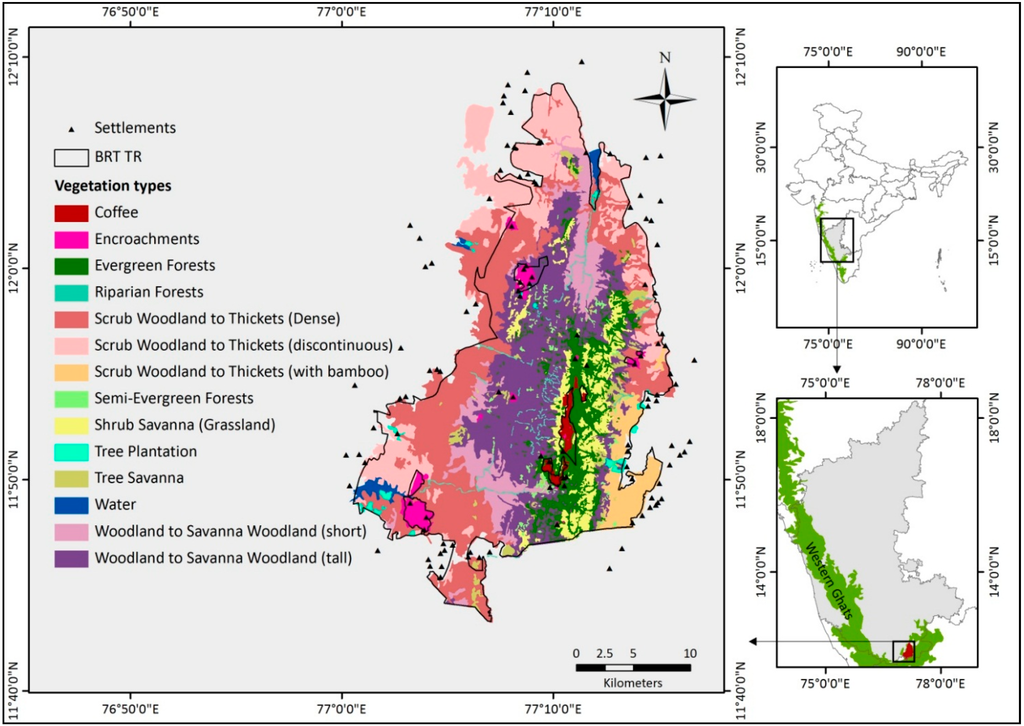
Figure 1.
Map showing the location of Biligiri Rangaswamy Temple Tiger Reserve (BRT) in the Western Ghats along with various vegetation types and human settlements.
2.1. Wildlife Corridors in Biligiri Rangaswamy Temple Tiger Reserve
2.1.1. Edeyarahalli-Doddasampige Corridor
The elephant range (regular elephant habitat) to the east of BRT has been divided by a long strip of fields and villages, extending south from Kollegal to the Tibetan settlement at Bylore for a distance of approximately 40 to 50 km (Figure 2). This strip cut-off the BRT forest from Ramapuram range forest of Kollegal division. Only a narrow corridor, Edeyarahalli-Doddasampige Corridor (hereafter Edeyarahalli corridor) exists between the villages of Boredoddi and Andipalya along with Kollegal-Satyamangalam state highway-17A (Figure 2).
The dimension of the corridor is 0.5 km in length and 2 km in width and the geographical coordinates are 11°55'15" to 11°56'15"N and 77°15'20" to 77°15'45"E. The major land uses practice in and around this corridor are human settlements and farming and also some fallow land as a result of human-wildlife conflict. Adjacent to this corridor, approx. 35.5 acres of private land have been purchased from local farmers to widen the corridor by WTI (Wildlife Trust of India). This was the pioneer corridor conservation approach in India [12].
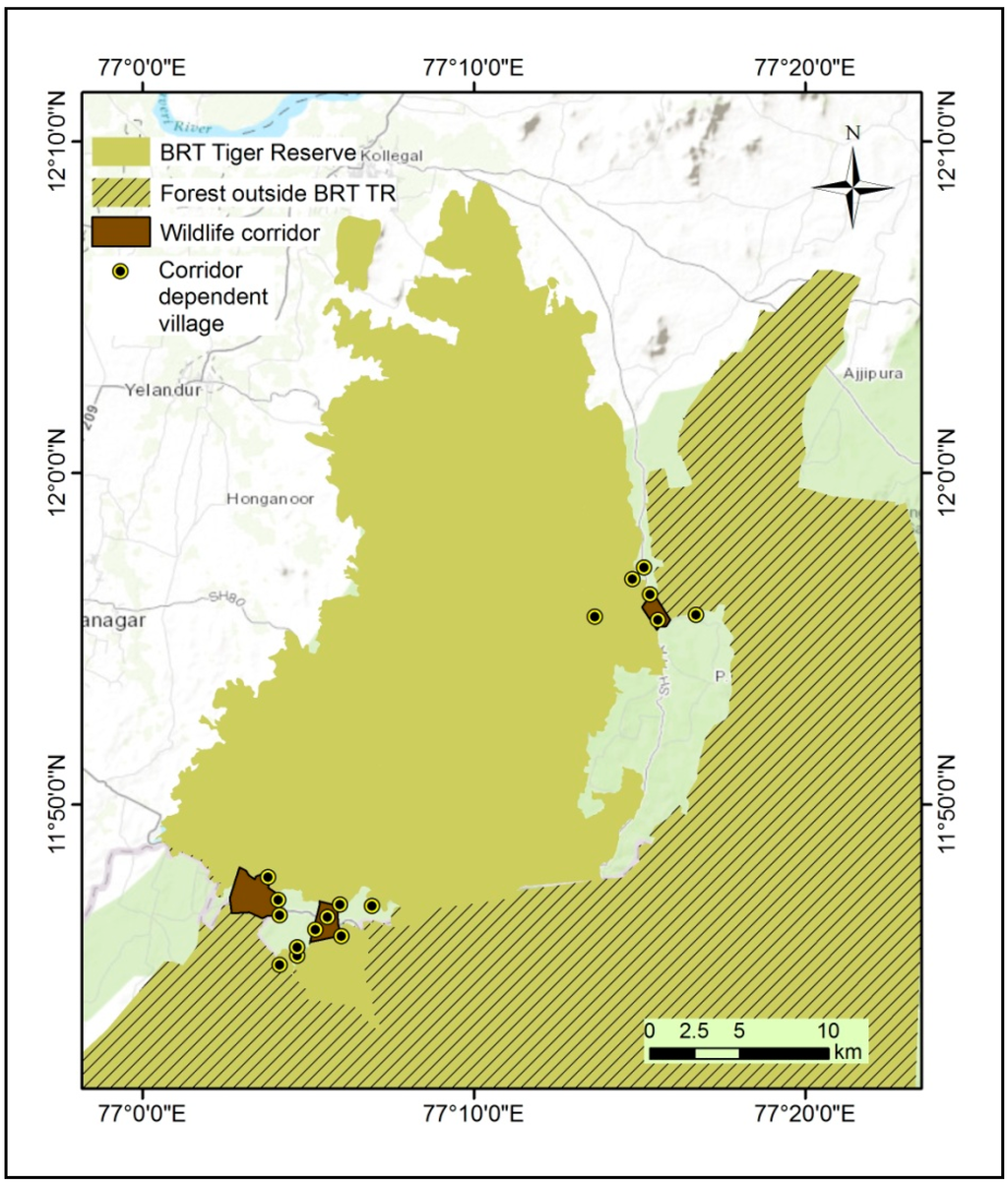
Figure 2.
Matrix of forests, wildlife corridors, dependent villages, farmland and road network in Biligiri Rangaswamy Temple Tiger Reserve (BRT).
2.1.2. Chamarajanagar-Talamalai Corridor at Punajanur
Chamarajanagar-Talamalai corridor at Punajanur (termed as Punjur-Kolipalya corridor in KETF report 2012, hereafter Punajanur corridor) is an important elephant corridor in BRT [14], identified and documented during the early 1980s [43]. This corridor (measures about 1.5 km in length and 1.5 km in width, located between 11°46'04'' to 11°47'00''N and 77°05'50'' to 77°06'03''E) provides an important passage for elephants as well as other large mammals in a north-south direction between two tiger reserves, BRT tiger reserve of Karnataka state and Sathyamangalam tiger reserve of Tamil Nadu state (Figure 2).
2.1.3. Chamarajanagar-Talamalai Corridor at Mudalli
To the west of the Punajanur corridor, another narrow corridor termed as Chamarajanagar-Talamalai corridor at Mudalli (hereafter Mudalli corridor) was identified, which measures about 1.5 km in length and 1.5 km in width and located between 11°46'20'' to 11°47'47''N and 77°02'10'' to 77°04'40''E. The movement of large mammals especially elephants are constrained by the steep terrain to the eastern part of Punajanur corridor. Therefore, Mudalli corridor is very close to the periphery of the elephant range and serves as an alternative migratory route for elephants as well as other large mammals (Figure 2).
The Chamarajanagar to Sathyamangalam national highway (NH-209) passes through both of these corridors, whereas the Talavadi-Mudalli state highway passes through the Mudalli corridor. A 24 h vehicular traffic survey revealed that an average of two vehicles per minute passed through the southern corridors that connected the BRT and Sathymangalam tiger reserves. In Edeyarahalli corridor, an average of one vehicle per minute was recorded on the state highway (SH-17A). This could be an additional threat to wildlife movement in the corridors [15].
3. Methods
3.1. Data Collection and Preparation
The study involved a number of steps: Data acquisition, data processing and data analysis and interpretation. The choice of satellite imagery was not only based on spatial and spectral resolution, but also availability and affordability for the particular season of the required years. The earliest satellite images available for this purpose were from 1973. Hence, the time series study years 1973, 2001 and 2014 were selected based on availability of quality data covering the study area. The data was collected in terms of both anthropogenic as well as natural variables that influence the changes. The analyses were carried out by using GIS software ArcMap 9.3, Idrisi Selva and ERDAS Imagine 9.2.
Scanned topographical maps of scale 1:50,000 were obtained from the Survey of India. The BRT tiger reserve boundary, corridors and adjacent forests were digitized from the Survey of India toposheets. Based on field data (GPS reading), all the settlements/villages in and around the corridors were mapped. Human population, livestock population and fuel wood collection data was attributed for each settlement/village point. This information on individual corridor villages was found to be more useful as the above mentioned anthropogenic activities were limited to a radius of 3 km around the settlements [2,11]. It also helped to understand the extent and relative use of forest resources by each corridor dependent village. The data used for this purpose was collected through (i) a questionnaire survey administered to 100 households; (ii) secondary data collected from respective village panchayats; and (iii) secondary data collected from Large-scale Adivasi Multipurpose Cooperative Societies (LAMPS).
3.2. Change Analysis
NDVI differencing method has been used in several change detection studies, such as Yuan and Elvidge (1996), Hayes and Sader (2001), Vicente-Serrano et al. (2008), Mancino et al. (2014) and Krishnaswamy et al. (unpublished) [44,45,46,47,48]. Change analysis was adopted from these studies and was conducted using satellite images of 1973, 2001 and 2014. Agricultural areas and clouds were removed from the images using on-screen digitization masking techniques. Images of 1973 (Landsat MSS), 2001 (Landsat 7) and 2014 (Landsat 8) were used to study the changes in the landscape through NDVI analysis over four decades within the PA (forest within BRT), corridors and also adjacent forests (forests outside BRT). All images used for analysis were selected from the dry season (Table 1) to reduce scene-to-scene variation, which may possibly occur due to sun angle, soil moisture, atmospheric condition, and vegetation phenology differences [46]. In addition to these, the change in the NDVI was most noticeable only during the dry season, and also cloud cover is more pronounced in the images of other seasons, which may potentially affect the change analysis process and real change in NDVI. Apart from that, since this region is under cloud cover for most part of the year and we used NDVI for assessing degree of greening/browning across the years, we are constrained to select imagery acquired in any one season, with minimal gap between the days of the year. Therefore, we feel it is better to use scenes from any single season and also keeping the imageries dates as close as possible across the years to facilitate comparison between the years. Overall, in this method we have attempted to improve upon the conventional NDVI differencing technique of identifying change trends by applying thresholds and computing quartiles to further classify the greening and browning areas as low, medium and high change categories.

Table 1.
Satellite data used for NDVI analysis in the forest corridor landscape of Biligiri Rangaswamy Temple Tiger Reserve (BRT).
| Image | Date | Resolution |
|---|---|---|
| Landsat MSS | 27 February 1973 | 60 m |
| Landsat 7 | 3 March 2001 | 30 m |
| Landsat 8 | 11 February 2014 | 30 m |
The NDVI is sensitive to changes in plant canopy and provides unique change information over red and NIR wavebands that compose the NDVI [49]. Basically the NDVI is a numerical indicator range from −1 to +1 that uses the visible and near-infrared bands of the electromagnetic spectrum, and can be calculated as a ratio of red and NIR bands of a sensor system and are represented by the following equation [50,51,52]
where, NIR and R are the pixel values of near infrared and red band of the satellite image, respectively.
The red waveband tends to be most sensitive to land cover change and exhibits the greatest contrast between vegetation and soil. The near-infrared waveband is sensitive to leaf area and structure, and facilitates detection of changes in plant health, phenology and vegetation cover [53]. NDVI was calibrated to nullify the atmospheric effects. The detailed three-step procedure of the analyses is given below.
3.2.1. NDVI Generation and Resolution Matching
NIR and red bands of Landsat MSS image from 1973 were re-sampled to 30 m pixel size to match the pixel size of the other two Landsat images from 2001 and 2014 by using nearest neighbor method. NDVI was calculated for each of the three years.
3.2.2. NDVI Calibration
Since the images were taken decades apart, there are chances of variations in atmospheric conditions during the image acquisition and this would potentially affect the pixel values. Even though NDVI is less susceptible to atmospheric effects, to reduce any possible effects these scenes were calibrated with each other. To do this, NDVI values were extracted from pixels, which are unlikely to have changed in vegetation biomass over the time periods under consideration.
For calibration, pixels were selected from deep water and relatively undisturbed interior forests, with the assumption that these would undergo negligible change over time [25,51,53]. Keeping the Landsat 8 imagery of 2014 as reference, regression equations were computed and applied to the imagery from 2001 and 1973.
3.2.3. Change Analysis
In our study, DN values were converted into TOA (top of atmosphere) reflectance using formulae provided by USGS [54,55,56]. NDVI of the 2001 and 1973 computed from TOA reflectance values are calibrated to the 2014 NDVI in order to minimize atmospheric effects. The calibrated NDVI images of 2001 and 1973 were then subtracted from NDVI of 2014 to obtain change scenes. The change in NDVI was assessed for the corridor, the PA, and adjacent reserve forests from 1973 to 2014. Though NDVI value ranges from −1 to +1 in this study the quantitative net NDVI change was defined in “percent change” between the years (1973, 2001 and 2014) and across the landscape. Positive values in the change scenes show “greening” and negative values show “browning”. Only extreme changes beyond this threshold were considered as real change (greening/browning). “No change” thresholds were determined to account for the effects of atmospheric changes. For this, NDVI change values were extracted for the same pixels that were used for calibration.
Quartiles were calculated for this dataset, and values falling in the range between 1st and 3rd quartiles were considered as “no change”. Thresholds were applied to create “greening”, “no change” and “browning” classes. These classes were separated again based on quartile values. For greening, up to 1st quartile was considered for “Low Greening”, 1st–3rd quartile as “Medium Greening” and above 3rd quartile as “High Greening”. Similarly for browning, up to 1st quartile was considered as “High Browning”, 1st–3rd quartile as “Medium Browning” and above 3rd quartile as “Low Browning”.
4. Results
4.1. Changes in Vegetation Cover
The estimation of change analysis demonstrates a significant change in the NDVI of the area of entire BRT, and other categories (corridors, forest within BRT and forests outside BRT) over the four decades. The net percent change in NDVI from 1973 to 2014 indicates that there was a drastic change (browning and greening effect) in the wildlife habitat (Figure 3) especially in and around the three corridors, fringe areas and adjacent forests (Figure 4 and Figure 5).
At landscape level, over four decades, 0.02%, 3.22% and 64.97% of the BRT landscape area has changed to high browning, medium browning and low browning, respectively. Similarly during the same period, 0.01% of the area shows high greening, 1.72% area shows medium greening, 18.83% area shows low greening and 28% forest did not show any change. Forest category wise, in terms of browning, high browning (0.48%) and medium browning (62.93%) was maximum in corridors and low browning (80.65%) was maximum in forests outside BRT. In terms of greening, maximum high greening was found in corridors (0.07%), medium and low green was found within BRT (4.27% and 29.69%, respectively). Thus we can infer that the BRT landscape was subjected to more browning than greening over the four decades.
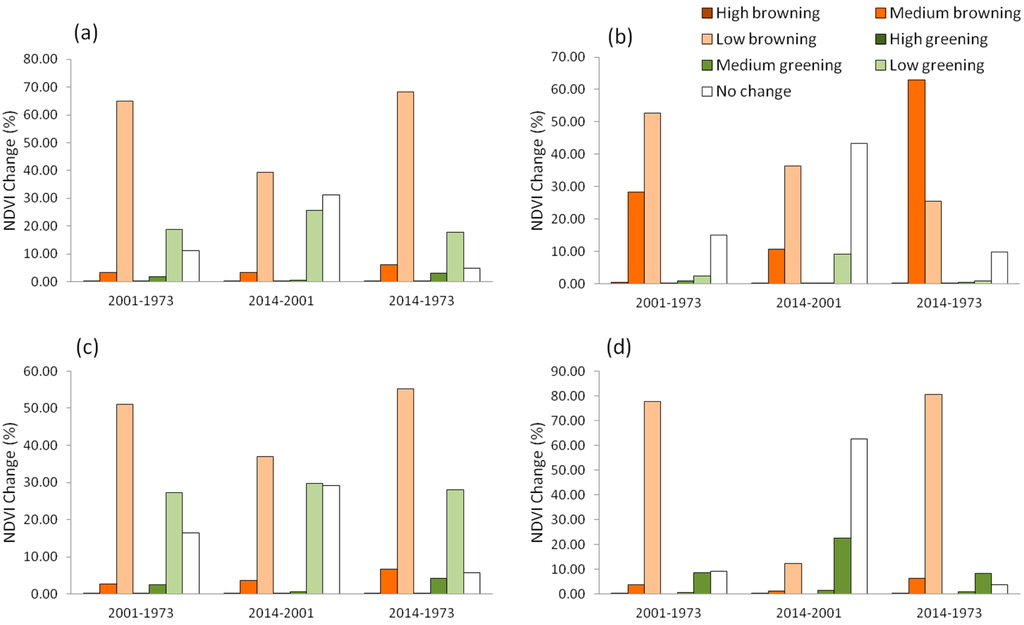
Figure 3.
Percent change in NDVI with respect to browning and greening over the four decades across the Biligiri Rangaswamy Temple Tiger Reserve (BRT) landscape ((a) entire landscape, (b) corridors, (c) forest within BRT and (d) forests outside BRT).
4.2. Drivers of Change
The visual inspection of change analysis between 1973 and 2001 map shows significant changes (more browning) compared to 2001–2014 due to various anthropogenic activities as well as natural processes that unfolded during that period.
4.2.1. Anthropogenic Drivers
In a period of four decades, Punajanur and Mudalli corridors were completely lost due to various anthropogenic pressures like establishment of settlements, agricultural expansion and the National Highway network. Near Punajanur corridor approximately 400 hectares of forest was cleared for settlers from Tamil Nadu. Similarly in Edeyarahalli corridor area also, approximately 1200 hectares forest was cleared for the establishing settlements and providing agricultural land as well as other infrastructure facilities for refugees came from Tibet [57]. Apart from these, BRT experienced some incidences of human-induced fire during this period. These activities were the major factors responsible for the wildlife habitat destruction adjacent to the corridors (Figure 4 and Figure 5).
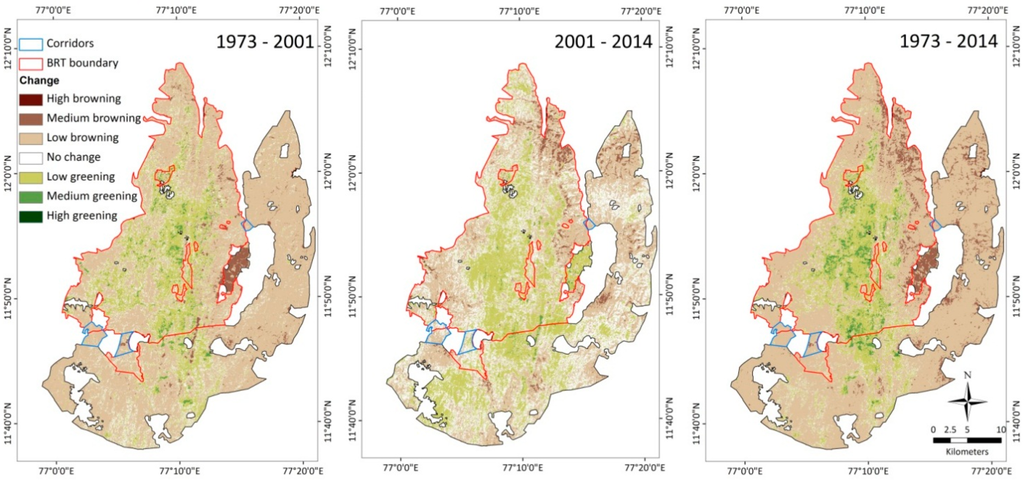
Figure 4.
Change analysis shows the NDVI changes in Biligiri Rangaswamy Temple Tiger Reserve (BRT) and adjacent forests from 1973–2001, 2001–2014 and 1973–2014.
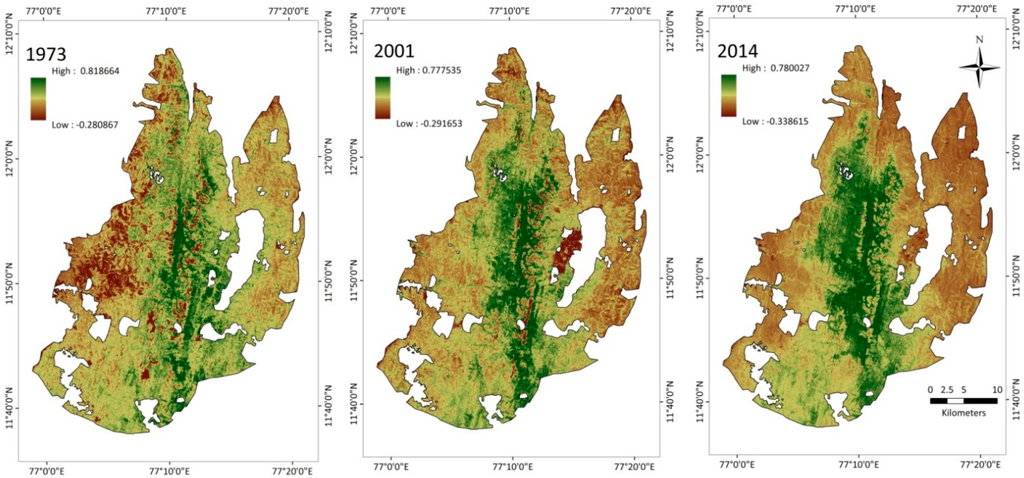
Figure 5.
NDVI maps of the Biligiri Rangaswamy Temple Tiger Reserve (BRT) landscape and the surrounding Edeyarahalli, Punajanur and Mudalli corridors in 1973, 2001 and 2014.
4.2.2. Natural Drivers
In terms of natural drivers, canopy disturbances such as self-thinning (personal observation) and dieback (e.g., mistletoe infestation on amla (Indian gooseberry) trees in BRT) could have caused negative impacts on some plant species and further to vegetation structure of the landscape [58,59]. Apart from that, a few consecutive drought years also caused a decline in the population of dry forest trees [60]. These natural processes might have been responsible for the negative trend in NDVI over the years. The change analysis between 2001 and 2014 shows that most of the greening (positive trend in NDVI) was found in the core area (moist forest) rather than the fringe area (scrub forest) of the reserve due to the rapid spread of an invasive plant species, Lantana camara (Figure 6).
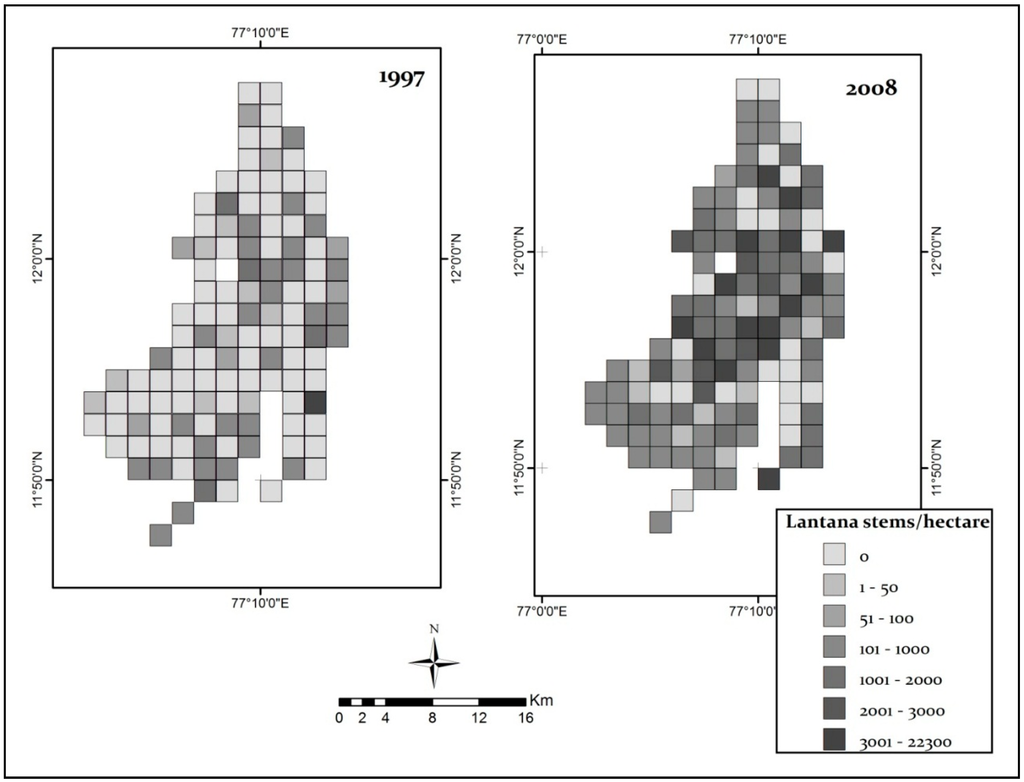
Figure 6.
Lantana camara spread in Biligiri Rangaswamy Temple Tiger Reserve (BRT) over a period of one decade. Map source: Hiremath and Sundaram 2014. Reproduced with permission from authors).
4.3. Measuring and Mapping of Anthropogenic Pressures
The variables that we used to assess the anthropogenic pressure in and around the corridors were human population (individuals per household), livestock population (individuals per household), NTFP collection and fuel wood collection (annual income per household). The change analysis of our study (Figure 7a) indicates more or less similar result that of the Figure 7b, the “composite threat index” map of BRT developed by Barve et al. (2005) by utilizing the same variables [11]. Additionally they included information on road networks and accessibility [11]. Mackenzie et al. (2011) also utilized the “number of stems harvested” as a variable to assess the anthropogenic disturbance in Uganda’s Kibale national park [6].
In terms of resource extraction, density of humans as well as livestock population, there is not much variation among these variables between the corridors (Figure 8 and Figure 9). The Welch’s F Test ANOVA result shows that, there is no significant difference between the corridors in terms of human population (F = 1.433, p = 0.2464) as well as livestock population (F = 1.27, p = 0.2878). In terms of forest resource collection also, there is no significant difference in fuel wood collection (F = 1.209, p = 0.3056) as well as NTFP collection (F = 0.4541, p = 0.6396) between the corridors.
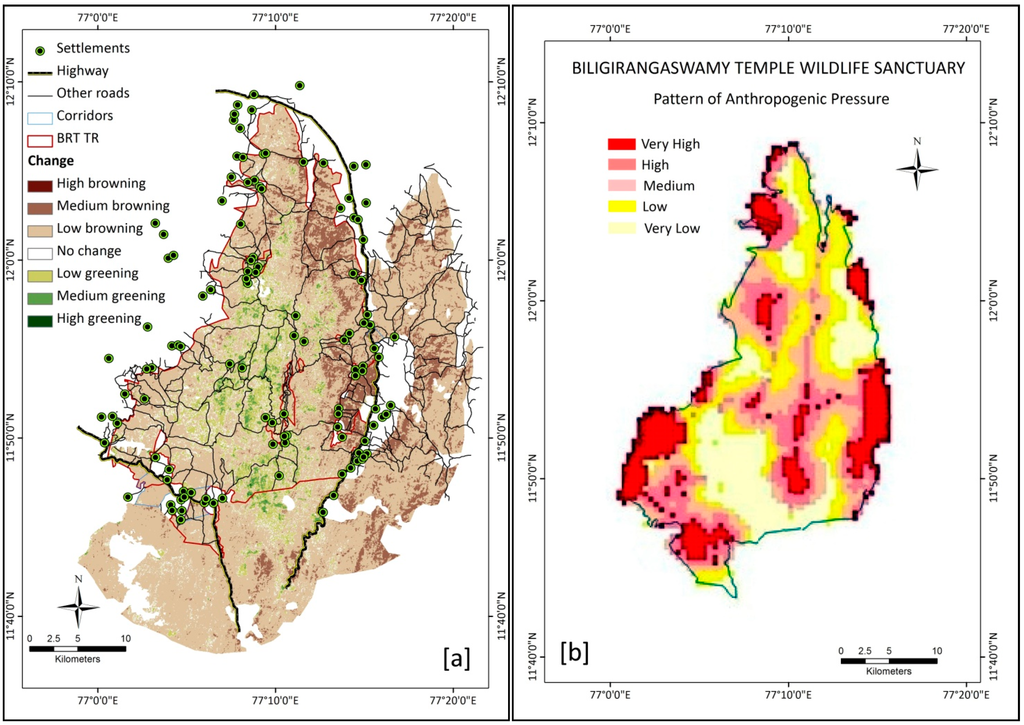
Figure 7.
(a) NDVI change, settlements and road networks in Biligiri Rangaswamy Temple Tiger Reserve (BRT). (b) Composite Threat Index map of BRT. (Map (b) source: Barve et al. 2005. Reproduced with permission from authors).

Figure 8.
Mean (± se) number of human and livestock population per household between three corridors of BRT. (n = 31, 39 and 30 households from Punajanur corridor (PC), Mudalli corridor (MC) and Edeyarahalli corridor (EC), respectively).
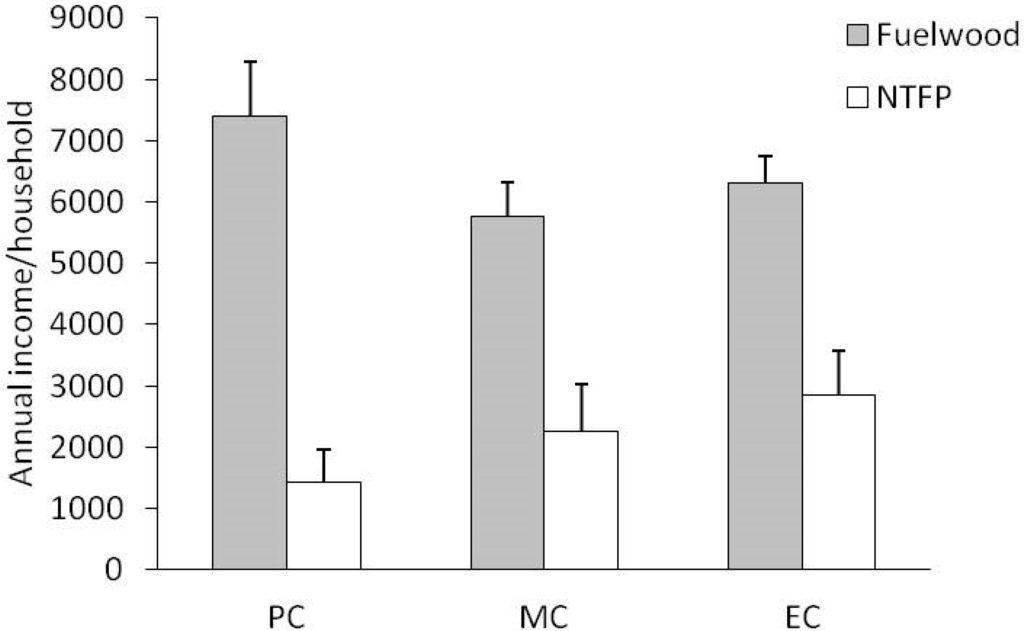
Figure 9.
Mean (± se) annual income per household in INR (1 USD = 60 INR, date 15 July 2014) from fuel wood collection and NTFP (non-timber forest products) collection between three corridors of BRT. (n = 31, 39 and 30 households from Punajanur corridor (PC), Mudalli corridor (MC) and Edeyarahalli corridor (EC), respectively).
Human population, livestock population and extent of fuel wood collection at village level were mapped to understand the relative disturbance level between the corridors (Figure 10). Information related to NTFP collection was not mapped because in 2007 the State Forest Department banned NTFP collection in BRT for commercial purpose. However, NTFP is collected at minor scale only for domestic consumption, which contributes to approximately 3% of their total income [61].
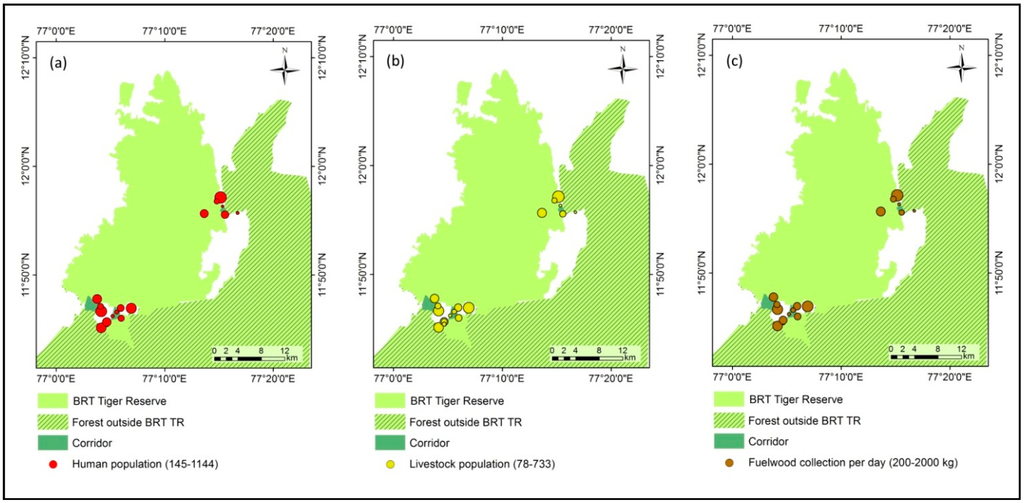
Figure 10.
Dependence on corridors by local people in Biligiri Rangaswamy Temple Tiger Reserve (BRT). (a) Human population per village, (b) livestock population per village, and (c) fuel wood collection per day per village (in kgs). In each class, the range is given in the bracket next to the circle and the size of the circle indicates the magnitude of the respective classes.
5. Discussion
Over the four decades between 1973 and 2014 we could see drastic changes not only in terms of LULC (land use and land cover) but also in NDVI across the BRT landscape due to various factors. The time series NDVI analysis of images drawn from the years 1973, 2001 and 2014 shows an obvious change, with NDVI being higher in earlier years. The NDVI for 1973 is higher compared to that for 2001, which, in turn, is higher than in 2014.
The NDVI change shows that most of the fringe and corridor areas are highly degraded and some part of wildlife habitat was lost over the years due to anthropogenic pressure (Figure 4 and Figure 5). The forest-corridor landscape experienced rapid population growth and increased settlements resulting in increased demand for forest resources especially NTFP, fuel wood and grazing in the wildlife habitat. Fuel wood has been collected intensively in the forest fringe area by non-tribal people for their own use as well as to generate income. Apart from that, large-scale farming and infrastructure development also increased over the years. These factors might have reduced the extent and the quality of wildlife habitat [62,63]. Similar results were found in the “composite threat index” map (Figure 7b) developed by Barve et al. (2005) for BRT [11]. This indicates that the change processes are complex, involving multiple driving factors such as socio-economic changes, high population growth, cultural beliefs, historical forest management practices and government policies. These factors are not only location specific and context dependent but also temporally dynamic [7].
Over the four decades in BRT, NDVI increased in the core area of the forest and reduced in the fringe areas (Figure 5). This could be due to rapid Lantana spread, drought and forest fire. Hiremath and Sundaram (2014) also show that in a decade Lantana density increased enormously in BRT (occurred in 81% of plots in 2007 and 41% of plots in 1997) and relatively more Lantana spread was found in moist deciduous forest compared to scrub (Figure 6) [64]. This could be one of the reasons for an increase in NDVI in the core area of BRT forest, mainly in the moist deciduous type. Contrastingly, during the same years the NDVI decreased in scrub forest mainly due to consecutive drought years from 2001 to 2005 [60] and could be a result of repeated forest fires. According to Goetz et al. (2005) fire is also one of the responsible factor for tree decline and habitat change and further to negative trend in NDVI [65].
In the context of BRT, forest fire management practices have changed over the decades because of strict fire control measures have been introduced in BRT following PA management guidelines. In the past as part of shifting cultivation and NTFP harvest, ground fire was used by the forest dwellers. The historical fire regimes could have not only maintained the grass growth better but also suppressed the invasive weeds such as Lantana camara and Chromolaena odorata [66]. But in the present situation, the altered fire regime could have impact on forests at multiple spatial scales and possibly led to forest degradation and increasing susceptibility to invasion by Lantana camara [66]. The spread and biomass quantity of Lantana camara has gone beyond the management through ground fire.
Apart from that, the vegetation type is also a decisive factor in forest fire. Tropical dry deciduous forests are more susceptible to fire due to a long dry season. The presence of a significant amount of flammable material like undergrowth of Lantana camara coupled with gusty winds could greatly enhance the intensity and extent of fire ending up in canopy fire. This could have led to loss of more adult trees and native understory plant community largely dominated by the grasses and shrubs. With more than 65% tropical dry deciduous forest and 80% Lantana camara cover, BRT has experienced frequent forest fires and vigorous Lantana spread over the years. As reported in Krause and Goldammer (2007) and Sundaram (2011) both these factors (fire and Lantana) are responsible for change in vegetation structure, species composition and forest dynamics [16,67]. Forest fires could also have a possible impact on ecological diversity of the forests (decline in tree cover and habitat change) leading to lack of ecological niches [68]. Thus, these factors could be further responsible for NDVI changes either positively or negatively in BRT and adjacent forests over the years.
For economically poor and forest dependent indigenous people like Soligas as well as a few other non-Soligas, NTFPs, fodder for livestock, fuel wood and timber requirement for domestic purpose were the most wanted and more extracted resources. This can be noticed in Figure 8 and Figure 9 (at the household level) and in Figure 10 (at the village level). Livestock holding is a sign of wealth and is also an alternative income generation activity of the household. This will help them cope with the vulnerability during adverse conditions. But contrary to this, Forest Department claiming there are nearly 40,000 individuals of livestock (major proportion belongs to non-tribal people who live along the forest fringes), which graze in and around the BRT and put severe pressure on the forest [31]. This may lead to competition between livestock and wild herbivores for grazing, and reduce the abundance of wild prey for carnivore animals [69] and affect forest regeneration. Apart from that, cattle may carry the risk of transmitting diseases to wild animals. They are also easy prey for wild carnivores due to their little anti-predator behavior. These factors may cause conflict between forest dependent community and forest managers [6].
The conservation of wild animals is directly related to the conservation of native vegetation but in the Indian scenario habitat conservation has not gained much importance compared to individual charismatic animal conservation. As a species elephant receives the highest protection from wildlife protection laws but the land over which it ranges does not have a similar level of protection [70]. Since the threats are location specific and context dependent, at least forest managers could give high priority to the critical areas like corridors and connectivity of the wildlife habitats which were identified by our study. At the face of current unprecedented rate of habitat destruction, these critical areas will favors ecological processes and subsequently support biodiversity conservation in this landscape [10].
Uncertainties, Errors, and Accuracies
The chances of uncertainty and error in remotely sensed data are heightened when analyses are performed without carrying out atmospheric correction, but we have taken care of that by converting DN to at-satellite reflectance [71]. Apart from that, NDVI computed from at-satellite reflectance images from different dates were normalized using regression method, thereby minimizing the errors due to atmospheric effects and sensor differences. In addition to this, errors were also minimized by selecting imageries with minimum cloud cover, and the small amount of cloud present was masked-out by manual digitizing. Since the NDVI differencing method used in this study presents changes in NDVI derived from satellite imagery of different historical dates, there is no prediction error involved here. Overall, we have taken care to avoid chances of uncertainty and error at every stage of the NDVI differencing method in this study.
6. Conclusions
Increasing anthropogenic pressure (human habitation, resource extraction, cattle grazing and forest fires) coupled with drought and invasion by Lantana has modified the corridors and adjacent forest ecosystems in BRT over the years. Over four decades, 0.02%, 3.22% and 64.97% of the BRT landscape area has changed to high browning, medium browning and low browning, respectively. Similarly during the same period, 0.01% of the area shows high greening, 1.72% area shows medium greening, 18.83% area shows low greening and 28% forest did not show any change. In the process, the significant amount of vegetation cover has been lost at a faster rate. Since vegetation structure is very important in shaping animal species assemblages, the models based on NDVI could play an important role in wildlife and forest conservation especially in the case of forest, which is invaded by alien plant species such as Lantana camara. Therefore, the long-term NDVI based time series remote sensing approach, serves as an effective tool for detecting landscape change. For places such as BRT and similar protected areas in Western Ghats, this approach could be used annually for long-term monitoring of the wildlife habitat particularly in and around corridor landscape to prioritize critical areas for conservation and management of wildlife.
Our study highlighted some ecologically important but degraded areas and the drivers responsible for degradation in and around the corridor landscape of the BRT tiger reserve. This spatial information will be useful to the forest managers to take a site-specific adaptive conservation measure to rejuvenate the functionality of the wildlife corridor at local scale. Without locale specific spatial information and analysis about the changes and the drivers, it is not easy to manage the landscape effectively, especially in mitigating the anthropogenic activities that lead to habitat modification and degradation [72]. This approach could be used in two ways, firstly to identify areas that are already in a critical state and secondly to predict spatially where the drivers could threaten the quality of habitat in future. Updated and accurate change detection highlighted in the study will not only be useful to make appropriate decision, influence appropriate policies but also to initiate action-oriented conservation planning such as restoration of green cover in degraded areas to facilitate safe wildlife migration, minimize the human wildlife conflict and, thus, conserve biodiversity across the larger landscape such as Western Ghats.
Acknowledgments
Funding for this project was provided by ATREE-NORAGRIC small grants. The article processing charge was paid through The Royal Norwegian Embassy Grants. We acknowledge, Karnataka State Forest Department for providing research permit to work in BRT Tiger Reserve. We thank Jagdish Krishnaswamy for his valuable inputs at the initial stage of the research. We extend our sincere thanks to Harini Nagendra, whose comments greatly improved the manuscript. Also we thank Muneeswaran Mariyappan, Prashanth Badrinath, Shivani Agarwal and Venkat Ramanujam for their comments during the course of manuscript writing.
Author Contributions
Paramesha Mallegowda, Ganesan Rengaian and Madhura Niphadkar developed the study design. Paramesha Mallegowda collected the data and performed the statistical analysis. Jayalakshmi Krishnan contributed towards image processing and map-making. All authors contributed to the writing of the manuscript.
Conflicts of Interest
The authors declare no conflict of interest.
References
- Hegde, R.; Suryaprakash, S.; Achoth, L.; Bawa, K.S. Extraction of non-timber forest products in the forests of Biligiri Rangan Hills, India. 1. Contribution to rural income. Econ. Bot. 1996, 50, 243–251. [Google Scholar]
- Murali, K.S.; Shankar, U.; Shaanker, R.U.; Ganeshaiah, K.N.; Bawa, K.S. Extraction of non-timber forest products in the forests of Biligiri Rangan Hills, India. 2. Impact of NTFP extraction on regeneration, population structure and species composition. Eco. Bot. 1996, 50, 252–269. [Google Scholar] [CrossRef]
- Cardillo, M.; Purvis, A.; Sechrest, W.; Gittleman, J.L.; Bielby, J.; Mace, G.M. Human population density and extinction risk in the world’s carnivores. PLoS Biol. 2004, 2, 909–914. [Google Scholar] [CrossRef]
- Fonkwo, N.S.; Angwafo, T.E.; Mbida, M. Abundance and distribution of large mammals in the Bakossi landscape area, Cameroon. J. Soil Sci. Environ. Manag. 2011, 2, 43–48. [Google Scholar]
- World Wide Fund for Nature. How effective are protected areas? In Proceedings of the Seventh Conference of Parties of the Convention on Biological Diversity, Kuala Lumpur, Malaysia, 9 February 2004; p. 24.
- MacKenzie, C.A.; Chapman, C.A.; Sengupta, R. Spatial patterns of illegal resource extraction in Kibale National Park, Uganda. Environ. Conserv. 2011, 39, 38–50. [Google Scholar] [CrossRef]
- Nduati, E.W.; Mundia, C.N.; Ngigi, M.M. Effects of vegetation change and land use/land cover change on land surface temperature in the mara ecosystem. Int. J. Sci. Res. 2013, 2, 22–28. [Google Scholar]
- Hanski, I. Metapopulation dynamics: Does it help to have more of the same? Trends Ecol. Evol. 1989, 4, 113–114. [Google Scholar] [CrossRef] [PubMed]
- Mc Neely, J.A.; Gadgil, M.; Leveque, C.; Padoch, C.; Redford, K. Human Influence on Biodiversity. In Global Biodiversity Assessment; Heywood, V.H., Watson, R.T, Eds.; UNEP, University Press: Cambridge, UK, 1995; pp. 711–821. [Google Scholar]
- Crooks, K.R.; Sanjayan, M. Connectivity Conservation; Cambridge University Press: Cambridge, UK, 2006. [Google Scholar]
- Barve, N.; Kiran, M.C.; Vanaraj, G.; Aravind, N.A.; Rao, D.; Uma Shaanker, R.; Ganeshaiah, K.N.; Poulsen, J.G. Measuring and mapping threats to a wildlife sanctuary in Southern India. Conserv. Biol. 2005, 19, 122–130. [Google Scholar] [CrossRef]
- Menon, V.; Tiwari, S.K.; Easa, P.S.; Sukumar, R. Right of Passage—Elephant Corridors of India; Wildlife Trust of India: Odisha, India, 2005; p. 287. [Google Scholar]
- Kumara, H.N.; Rathnakumar, S.; Sasi, R.; Singh, S. Conservation of wild mammals in Biligiri Rangaswamy Temple Wildlife Sanctuary, Western Ghats, India. Curr. Sci. 2012, 103, 933–940. [Google Scholar]
- KETF. Karnataka Elephant Task Force Report; High Court of Karnataka: Karnataka, India, 2012; p. 150. [Google Scholar]
- Mallegowda, P. Do wildlife corridors need protection? Sanctuary Asia 2012, 32, 70–71. [Google Scholar]
- Sundaram, B. Pattern and Process of Lantana Camara Persistence in South Indian Tropical Dry Forests. Ph.D. Thesis, Manipal University, Manipal, Karnataka, India, 2011. [Google Scholar]
- Forman, R.T.T. Land Mosaics: The Ecology of Landscapes and Regions; Cambridge University Press: Cambridge, UK, 1997; p. 632. [Google Scholar]
- Franklin, A.B.; Noon, B.R.; George, T.L. What is habitat fragmentation? Stud. Avian Biol. 2002, 25, 20–29. [Google Scholar]
- Lord, J.M.; Norton, D.A. Scale and the spatial concept of fragmentation. Conserv. Biol. 1990, 4, 197–202. [Google Scholar] [CrossRef]
- Wiens, J.A. Habitat fragmentation: Island vs. landscape perspectives on bird conservation. Ibis 1994, 137, S97–S104. [Google Scholar] [CrossRef]
- Hall, L.S.; Krausman, P.R.; Morrison, M.L. The habitat concept and a plea for standard terminology. Wildl. Soc. Bull. 1997, 25, 173–182. [Google Scholar]
- Yarrow, G. Habitat Requirements of Wildlife: Food, Water, Cover and Space; Fact Sheet 14; Cooperative Extension’s Forestry & Natural Resources, Clemson University: Clemson, SC, USA, 2009; p. 5. [Google Scholar]
- Meneses-Tovar, C.L. NDVI as indicator of degradation. Unasylva 238 2011, 62, 39–46. [Google Scholar]
- Das, D.J.; Kumar, V.; Bora, H.R.; Verma, P.K.; Gogoi, P.; Gogoi, G.; Vasu, N.K. Land cover mapping and dynamics of Kaziranga National Park, Assam, India. Indian For. 2014, 140, 11–17. [Google Scholar]
- Jensen, J.R. Remote Sensing of the Environment: An Earth Resource Perspective; Prentice Hall: Upper Saddle River, NJ, USA, 2000; p. 544. [Google Scholar]
- Michener, W.K.; Houhoulis, P.F. Detection of vegetation changes associated with extensive flooding in a forested ecosystem. Photogramm. Eng. Remote Sens. 1997, 63, 1363–1374. [Google Scholar]
- Justice, C.O.; Townshend, J.R.G.; Holben, B.N.; Tucker, C.J. Analysis of the phenology of global vegetation using meteorological satellite data. Int. J. Remote Sens. 1985, 6, 1271–1318. [Google Scholar] [CrossRef]
- Reed, B.C.; Brown, J.F.; VanderZee, D.; Loveland, T.R.; Merchant, J.W.; Ohlen, D.O. Measuring phenological variability from satellite imagery. J. Veg. Sci. 1994, 5, 703–714. [Google Scholar] [CrossRef]
- Verbyla, D. Browning boreal forests of western North America. Environ. Res. Lett. 2011, 6, 3. [Google Scholar] [CrossRef]
- Forkel, M.; Carvalhais, N.; Verbesselt, J.; Mahecha, M.D.; Neigh, C.S.; Reichstein, M. Trend change detection in NDVI time series: Effects of inter-annual variability and methodology. Remote Sens. 2013, 5, 2113–2144. [Google Scholar] [CrossRef]
- Gogi, V.K. Draft Management Plan and Annual Action Plan of BRT Wildlife Sanctuary; Chamarajanagar Division, Karnataka Forest Department: Karnataka, India, 2001; p. 175. [Google Scholar]
- Karnataka Forest Department. Available online: https://164.100.133.59/aranya/?page_id=213 (accessed on 8 October 2014).
- Ganeshaiah, K.N.; Uma Shaanker, R.; Bawa, K.S. Biligiri Rangaswamy Temple Wildlife Sanctuary: Natural History, Biodiversity and Conservation; ATREE and VGKK: Bangalore, India, 1998. [Google Scholar]
- Kammathy, R.V.; Rao, A.S.; Rao, R.S. A contribution towards a flora of Biligirirangan Hills, Mysore State. Bull. Bot. Survey India 1967, 9, 206–234. [Google Scholar]
- Ramesh, B.R. Flora of Biligirirangan Hills. Ph.D. Thesis, Madras University, Chennai, India, 1989. [Google Scholar]
- Srinivasan, U.; Prashanth, N.S. Preferential routes of bird dispersal to the Western Ghats in India: An explanation for the avifaunal peculiarities of the Biligirirangan Hills. Indian Birds 2006, 2, 114–119. [Google Scholar]
- Srinivasa, T.S.; Karthikeyan, S.; Prasad, J.N. Faunal Survey of the Biligirirangan Temple Wildlife Sanctuary; Merlin Nature Club: Bangalore, India, 1997. [Google Scholar]
- CEPF Report: Critical Ecosystem Partnership Fund. India, 2007; 94.
- The IUCN Red List of Threatened Species. Available online: http://www.iucnredlist.org (accessed on 10 January 2010).
- Mandal, S.; Rai, N.D.; Madegowda, C. Culture conservation and co-management: Strengthening Soliga stake in biodiversity conservation in Biligiri Rangaswamy temple wildlife sanctuary, India. In Sacred Natural Sites: Conserving Nature and Culture; Verschuuren, B., Wild, R., McNeely, J., Oviedo, G., Eds.; Routledge: London, UK, 2010; pp. 263–271. [Google Scholar]
- Setty, R.S. Ecology and Productivity Studies on Some Non-Timber Forest Products of Biligiri Rangaswamy Temple Wildlife Sanctuary. Ph.D. Thesis, Botany Department, University of Mysore, Mysore, Karnataka, India, 2004. [Google Scholar]
- Paramesha, M. Sourcing local solutions for conflict. Curr. Conserv. 2012, 5, 30–31. [Google Scholar]
- Sukumar, R. Ecology and Management of the Asian Elephant (Elephas Maximus) in Southern India with Special Reference to the Sathyamangalam and Chamarajanagar Forest Divisions; Technical Report; Centre for Ecological Sciences, Indian Institute of Science: Bangalore, India, 1985. [Google Scholar]
- Krishnaswamy, J.; Bawa, K.S.; Kiran, M.C. Analyzing Effectiveness of Protected Areas in Protecting Forest Biomass, Unpublished Work.
- Yuan, D.; Elvidge, C.D. Comparison of relative radiometric normalization techniques. ISPRS J. Photogra. Remote Sens. 1996, 51, 117–126. [Google Scholar] [CrossRef]
- Hayes, D.J.; Sader, S.A. Comparison of change detection techniques for monitoring tropical forest clearing and vegetation regrowth in a time series. Photogramm. Eng. Remote Sens. 2001, 67, 1067–1075. [Google Scholar]
- Vicente-Serrano, S.M.; Pérez-Cabello, F.; Lasanta, T. Assessment of radiometric correction techniques in analyzing vegetation variability and change using time series of Landsat images. Remote Sens. Environ. 2008, 112, 3916–3934. [Google Scholar] [CrossRef]
- Mancino, G.; Nolè, A.; Ripullone, F.; Ferrara, A. Landsat TM imagery and NDVI differencing for vegetation change detection: Assessing natural expansion of forests in Basilicata, Southern Italy. iForest 2014, 7, 75–84. [Google Scholar] [CrossRef]
- Coulter, L.; Stow, D.; Hope, A.; O’Leary, J.; Franklin, J.; Johnson, A.; Witztum, E.; Petersen, A.; Longmire, P.; Wall, A.; et al. Regional Change Monitoring of Habitat Reserve Systems with Very High Resolution Remotely Sensed Data; NASA Earth Science Directorate Final Report; Food and Fiber Applications of Remote Sensing, 2003; p. 173. [Google Scholar]
- Rouse, J.W.; Hass, R.H.; Schell, J.A.; Deering, D.W. Monitoring vegetation systems in the Great Plains with ERTS. In Proceedings of the Third Earth Resources Technology Satellite-1 Symposium, Greenbelt, Washington, DC, USA, 10–14 December 1973.
- Campbell, J.B. Introduction of Remote Sensing; The Guilford Press: New York, NY, USA, 1987. [Google Scholar]
- Lillesand, T.M.; Kiefer, R.W. Remote Sensing and Image Interpretation, 4th ed.; John Wiley & Sons: Hoboken, NJ, USA, 2005. [Google Scholar]
- Hall, F.G.; Strebel, D.E.; Nickeson, J.E.; Goetz, S.J. Radiometric reflection: Toward a common radiometric response among multidate multisensor images. Remote Sens. Environ. 1991, 35, 11–27. [Google Scholar] [CrossRef]
- Chander, G.; Markham, B.L.; Helder, D.L. Summary of current radiometric calibration coefficients for Landsat MSS, TM, ETM+, and EO-1 ALI sensors. Remote Sens. Environ. 2009, 113, 893–903. [Google Scholar] [CrossRef]
- Landsat 7 Science Data Users Handbook. Available online: http://landsathandbook.gsfc.nasa.gov/pdfs/Landsat7_Handbook.pdf (accessed on 2 October 2014).
- Using the USGS Landsat 8 Product. Available online: http://landsat.usgs.gov/Landsat8_Using_Product.php (accessed on 2 October 2014).
- Dhondenling Tibetan Settlement, Kollegal. Available online: http://www.centraltibetanreliefcommittee.org/settlements/india/south/dhondenling.html (accessed on 24 December 2010).
- Coppin, P.; Jonckheere, I.; Nackaerts, K.; Muys, B.; Lambin, E. Digital change detection methods in ecosystem monitoring: A review. Int. J. Remote Sens. 2004, 25, 1565–1596. [Google Scholar] [CrossRef]
- Rist, L. Assessing a Threat to Sustainable NTFP Harvest Using Ecological Data and Traditional Ecological Knowledge. Ph.D. Thesis, Imperial College London, London, UK, 2009. [Google Scholar]
- Ticktin, T.; Ganesan, R.; Paramesha, M.; Setty, S. Disentangling the effects of multiple anthropogenic drivers on the decline of two tropical dry forest trees. J. App. Ecol. 2012, 49, 774–784. [Google Scholar] [CrossRef]
- Sandemose, P. Local People and Protected Areas: The Ban of NTFP Collection for Commercial Use and Effects on Cash Incomes and Livelihoods of the Soligas in BR Hills, India. Master’s Thesis, Norwegian University of Life Sciences, Ås, Norway, 2005. [Google Scholar]
- Stow, D.; Coulter, L.; Johnson, A.; Petersen, A.; O’Leary, J. Monitoring detailed land-cover changes in shrub land habitat reserves using multi-temporal IKONOS data. Geocart. Int. 2004, 19, 95–102. [Google Scholar] [CrossRef]
- Jones, T.; Bamford, A.J.; Ferrol-Schulte, D.; Hieronimo, P.; McWilliam, N.; Rovero, F. Vanishing wildlife corridors and options for restoration: A case study from Tanzania. Trop. Conserv. Sci. 2012, 5, 463–474. [Google Scholar]
- Hiremath, A.J.; Sundaram, B. Chapter 12: Invasive plant species in Indian protected areas: Conserving biodiversity in cultural landscapes. In Plant Invasions in Protected Areas: Patterns, Problems and Challenges; Foxcroft, L.C., Pysěk, P., Richardson, D.M., Genovesi, P., Eds.; Springer: Dordrecht, The Netherlands, 2014; pp. 241–266. [Google Scholar]
- Goetz, S.J.; Bunn, A.G.; Fiske, G.J.; Houghton, R. Satellite-observed photosynthetic trends across boreal North America associated with climate and fire disturbance. Proc. Natl. Acad. Sci. USA 2005, 102, 13521–13525. [Google Scholar] [CrossRef] [PubMed]
- Hiremath, A.; Sundaram, B. The fire-lantana cycle hypothesis in Indian forests. Conserv. Soc. 2005, 3, 26–42. [Google Scholar]
- Kraus, P.D.; Goldammer, J.G. Fire regimes and ecosystems: An overview of fire ecology in tropical ecosystems. In Proceedings of the Forest Fires in India, Madurai, India, 19–23 February 2007; pp. 9–13.
- Narendran, K. Forest fires: Origins and ecological paradoxes. Resonance 2001, 6, 34–41. [Google Scholar] [CrossRef]
- Woodroffe, R.; Thirgood, S.; Rabinowitz, A. People and Wildlife, Conflict or Co-Existence? Cambridge University Press: Cambridge, UK, 2005; p. 497. [Google Scholar]
- Down To Earth. Elephant Conservation Is Not Exactly Anybody’s Priority. Available online: http://www.downtoearth.org.in/content/elephant-conservation-not-exactly-anybody-s-priority (accessed on 1 March 2014).
- Huang, C.; Yang, L.; Homer, C.; Wylie, B.; Vogelman, J.; DeFelice, T. At-Satellite Reflectance: A First Order Normalization of Landsat 7 and ETM+ Images; USGS: Reston, VA, USA, 2001. Available online: http://landcover.usgs.gov/pdf/huang2.pdf (accessed on 24 December 2014).
- Liu, X.; Jin, Q.; Li, J.; Zhang, S. Landscape’s change detection in the southern slope of the Qinling Mountains, China. In Proceedings of the 20th ISPRS Congress Istanbul 2004, Istanbul, Turkey, 12–13 July 2004; Volume 35, pp. 854–860.
© 2015 by the authors; licensee MDPI, Basel, Switzerland. This article is an open access article distributed under the terms and conditions of the Creative Commons Attribution license (http://creativecommons.org/licenses/by/4.0/).